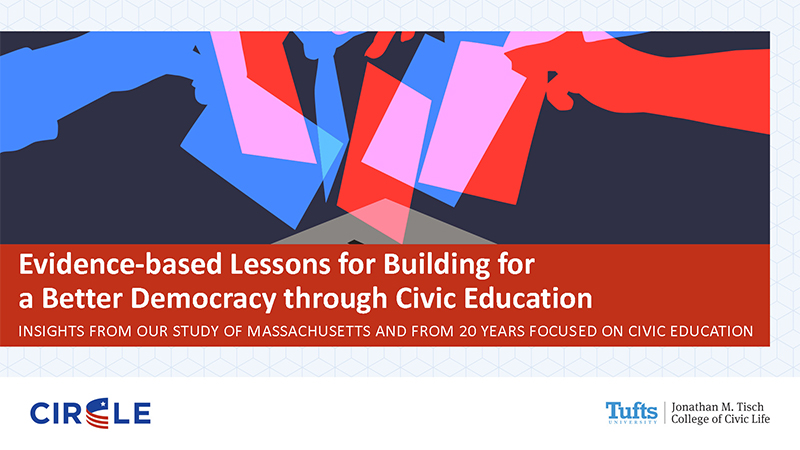Building a Better Democracy through Civic Engagement
Forum shares research and insights on reintroducing and integrating a civics curriculum into Massachusetts public schools
January 22, 2021
We spend $54 per enrolled student nationwide every year on STEM.
And 5¢ on civics.
Understanding the connection between gaps in civics education and gaps in civil behavior inspired the Boston Foundation’s partnership with the Tisch School of Civic Life at Tufts University for a January 22, 2021, forum to highlight research and ideas about how best to integrate civics education in our public schools. The online event was the latest in a partnership between the Foundation and a coalition of organizations highlighting the need for civics education in Massachusetts schools.
The Mass Civic Learning Coalition, of which the Boston Foundation is a member, successfully lobbied in 2018 for the passage of Act 296: An Act to Promote and Enhance Civic Engagement, which changed the pedagogical landscape by establishing a Civics Trust Fund that would help districts deliver on new requirements for civics education, which included revisions to existing civics and social studies frameworks, and requirements for students to complete student-led civics projects in grade 8 and again in high school (starting in the current academic year).
Boston Foundation Vice President of Communications and Public Affairs Keith Mahoney opened the forum, which featured presentation and discussion of a report from Tisch’s Center for Information & Research on Civic Learning and Engagement (CIRCLE) entitled The State of Civic Education in Massachusetts.
Conducted by researchers at CIRCLE, Wheelock College of Education & Human Development at Boston University and the Massachusetts Department of Early and Secondary Education, the study revealed an overall commitment from educators, but also recognized barriers faced by some. At the younger grades, teachers felt less confident in their understanding of the 2018 History and Social Studies Framework and more pressed for time to plan and instruct. Those conditions were amplified in districts with a high proportion of economically disadvantaged students. The research also showed the power of professional development, with teachers who got that support feeling much more able to implement civics instruction.
Dean Alan D. Solomont of the Jonathan M. Tisch College of Civic Life at Tufts moderated a conversation following presentation that dug into some details of the report with the researcher/panelists:
- Noorya Hayat, CIRCLE Senior Researcher, Tufts University
- Reuben Henriques, History & Social Science Content Lead, Massachusetts Department of Elementary & Secondary Education
- Kei Kawashima Ginsberg, CIRCLE Director, Tufts University
- Ariel Tichnor-Wagner, Lecturer at Wheelock College of Education & Human Development, Boston University
Conversation ranged from the practicality of adding civics to the curriculum during a pandemic, to how out-of-school organizations or community members could support educators, to ideas for teaching civics through math (geospacial geometry-based redistricting, anyone?). Civics, as Kawashima Ginsberg quoted the report, is “the plate” on which other subjects can be served, but teachers need and are eager for professional development to understand how to weave it in, and for resources to make that happen more seamlessly across the curriculum. Interestingly, many of today’s teachers were students in an era without much attention to civics in school, adding even greater importance to civics professional development beyond the social studies department.
One question from the audience asked how civics came to be neglected in schools. With implementation of the MCAS standardized tests, which have focused on math and English language arts, Henrique noted, instructional time for history and civics fell off—an unfortunately false tension, he added, since reading and language skills can be built through social studies. Hayat noted more generally the recent decades’ emphasis on STEM learning and teacher development. “Things that aren’t tested get deprioritized,” she said.
Indeed that STEM focus dates far back into the 20th century, as Solomont referenced in his closing words. “A generation ago Americans awoke to the news that the Soviet Union—our arch enemy at the time—had launched a satellite into orbit around the Earth. That Sputnik moment caused America to dedicate itself to teaching science and engineering in our schools.” Because what we witnessed in the nation’s capital on January 6 did not reflect the principles of our republic and “set a terrible example of civic participation for young people,” while being dramatic and upsetting, it may be that “we have arrived at a new ‘Sputnik moment,’” Solomont said, “when civic education is the priority. When civil discourse becomes the norm. When educators talk about difficult issues and deliberate across differences as an antidote to our increasingly polarized civic life.” He thanked the panelists and audience and urged people to reach out to their local school administrators, teachers and others in support of a solid civics curriculum.
“All of us are here today because we care about civic education and we understand that it is the foundation of a thriving democracy, he added. “It is up to all of us together. We must make sure that young people are prepared to participate in civic life to heal and strengthen our democracy to help shape a better future for themselves and for all of us.”

